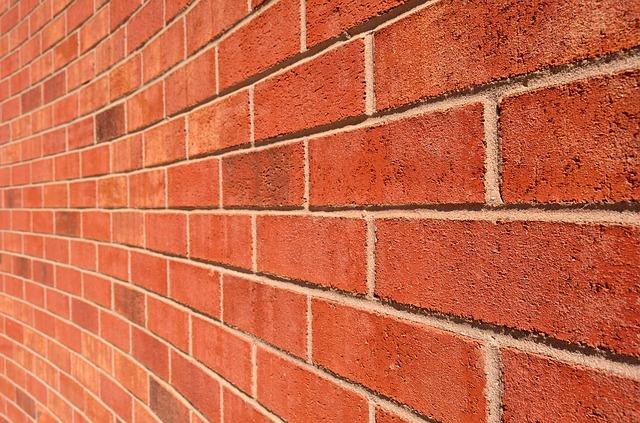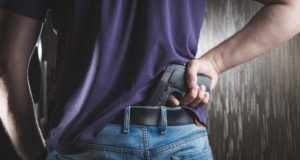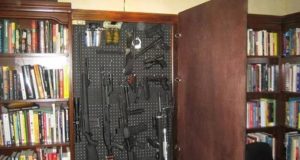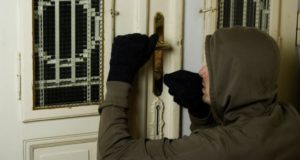There are a lot of false ideas floating around about what works as cover — in other words, what sorts of things will protect you from getting shot. We’ve all seen actors on television turn a table on its side and hide behind it to shoot, or duck behind a corner and see the bullets hit the wall, but not penetrate it. This has left us with a false idea of how well common items will protect us from the damage caused by flying bullets.
Your Home Isn’t Bulletproof
In reality, there is little in a home that will stop a bullet. Appliances are often made of sheets of steel that are much too thin to stop a bullet, even a smaller caliber bullet like a .22 LR. Furniture is made of materials that don’t stand a chance against a bullet, even if it’s “heavy” furniture. Interior walls aren’t much better. Made of drywall and studs, a typical bullet can pass through several interior walls before losing enough energy to stop.
It is rumored that in the Old West they said that a .44 bullet (supposedly the most common round of the day) would pass through six inches of pine. If you think about it, that’s quite a bit. My personal testing has shown that a 9mm FMJ, which has more penetrating power than just about any round available, will just barely make it through that six inches. But to be honest, I used stacked-up pieces of plywood, which probably was harder to penetrate.
When you compare that to your home, you see that there is little chance of anything in your home coming close to stopping a pistol round, let alone a rifle round that has much more penetrating power.
Some might say, “But the brick of the home would stop bullets!” I used to think that, too. But then I stuck some bricks together and shot at them. Sadly, I found that the only bullet a typical brick will stop is a .22 LR. Everything else, from a .380 on up, busted through the brick. You see, the air holes in the brick weaken it tremendously. If it was solid, it would probably do much better.
Now, to be fair to the brick, let me say that I had stuck them together with construction adhesive and I didn’t have the weight of an entire wall. It is possible that the weight of the wall above the brick that is hit by the bullet would help hold the brick together, reducing the penetrating power of the bullet. But I wouldn’t want to bet my life on it.
Why Bulletproof Walls?
So if your home isn’t bulletproof, what can you do? I mean, if you’re stuck in your home and have a bad guy outside, how do you fight effectively, without getting shot? Or if you live in a neighborhood where, sadly, there may be drive-by shootings, is there a solution?
Fortunately, the U.S. Army solved that problem long ago with an extremely low-tech answer. That is, the humble sandbag. Sandbags are effective at stopping anything and everything, up to and including .50 caliber machine gun bullets. Granted, enough machine gun bullets would tear the sandbags up, destroying their defensive capability, but that’s not likely to happen to you.
Be Prepared. Learn The Best Ways To Hide Your Guns.
A one-foot-thick sandbag wall is enough to stop any rifle and pistol bullet. Any home that is built to meet the requirements of the Uniform Building Code (UBC) will have floors strong enough to support a three-foot-high, one-foot-thick sandbag wall. Actually, they’ll probably support a bit more than that, but that’s all we’re concerned about. In a crisis situation, if you built such a wall below your windows, you’d have perfect firing positions to use in the defense of your home.
Something a Bit More Permanent
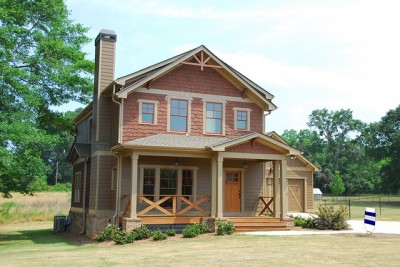 The only problem with the sandbag wall is that it’s a bit unsightly. I mean, who really wants sandbags stacked up in their living room or bedroom? That’s best left for emergencies only. But there are solutions which can be used more permanently, building the protection into your home.
The only problem with the sandbag wall is that it’s a bit unsightly. I mean, who really wants sandbags stacked up in their living room or bedroom? That’s best left for emergencies only. But there are solutions which can be used more permanently, building the protection into your home.
Fiberglass
One solution is to buy the fiberglass panels that they use for making the walls of a safe room. They’re made of woven roving and high shear strength epoxy. Depending on the thickness of the panels you buy, these will stop anything up to and including 7.62mm rifle fire.
While an expensive option, this is one that is highly effective. These panels can be installed underneath the drywall inside the home, hidden away but still offering protection.
Ballistic Steel
Another material option, other than the fiberglass panels, is ballistic steel plate. Please note that for this to work, you need to buy ballistic steel, not just any steel. The steel you can buy in the hardware store or your local steel supply is what is known as “cold rolled steel,” which isn’t anywhere near as strong as ballistic steel.
A one-quarter-of-an-inch thick ballistic steel plate will protect you from rifle fire, up to 5.56mm x 45 NATO and .308 Winchester ammunitions. It will not protect you from any armor piercing rounds or larger calibers, like .50 cal.
Once again, the steel plate can be hidden under the wallboard, making it a permanent but unobtrusive addition to your home. But, like the fiberglass panels, it’s going to be an expensive option.
Sand
There is one inexpensive way that you can make your walls at least somewhat bulletproof. That is to fill them with packed sand. A home wall usually has 3 ½ inches of empty space in it, except where there are studs, wires and pipes. If you were to remove the insulation and fill that area with sand, it would stop at least all pistol rounds, although that isn’t enough sand to stop rifle rounds. Please keep in mind that the sand would have to be packed for this to work; loose sand isn’t as effective.
In order to fill walls with sand, you have to cover both sides with plywood. They can’t be covered with drywall or with the foam sheeting that is commonly used as sheathing on homes. The plywood should be screwed to the studs, rather than nailed, so that it can’t pull out.
What advice would you add on constructing bulletproof walls? Share it in the section below:
Pump Shotguns Have One BIG Advantage Over Other Shotguns For Home Defense. Read More Here.
 Off The Grid News Better Ideas For Off The Grid Living
Off The Grid News Better Ideas For Off The Grid Living

